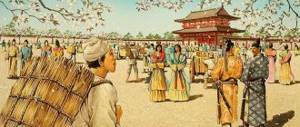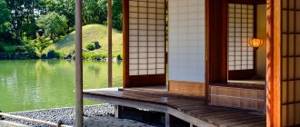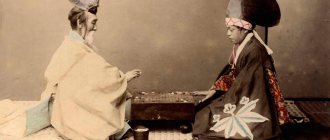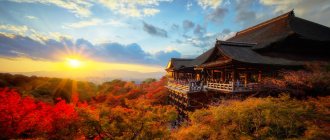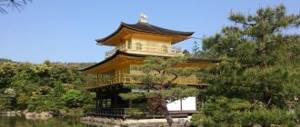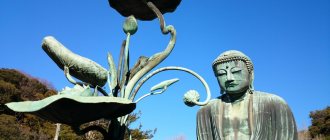Kyoto is the ancient capital of Japan. It was this city that was the residence of the Emperor for many millennia. A huge number of temples, parks and gardens are what characterizes Kyoto from a tourist point of view. To superficially explore the most popular temples, you need at least a week. But, if you only have a couple of days allotted to Kyoto, don’t despair. In my article I will write about the most visited attractions that can be visited in 1, 2 or 3 days.
Unknowingly, I allocated only two days to Kyoto in our itinerary. If you are coming to Japan for more than a week, reduce the number of days in Tokyo and increase the time to visit Kyoto. Because the most traditional, ancient sights of Japan are concentrated here.
What to see in Kyoto
Of course, the Golden Temple of Kinkaku-ji , the Temple of Pure Water Kiyomizu-dera , the Ryoan-ji in Kyoto.
I chose a hotel directly opposite the station - well located, I appreciated it: Hotel New Hankyu Kyoto: at the station there are bus stops that are the best way to get around Kyoto. A day pass costs 500 yen. For information, a separate article: Traveling from Tokyo to Kyoto by high-speed train - Shinkansen. it rained
in Kyoto
Nijo Castle
Laconic but elegant, Nijo Castle is considered an architectural treasure of Japan. The site is included in the UNESCO list, so it is difficult to underestimate its historical significance.
The castle in Kyoto was ordered to be built by Prince Minamoto in the 17th century. 25 years after the death of the talented commander, this castle was completed by his grandson.
The Tokugawa dynasty ruled Nijo for several centuries. The castle complex was named after the road next to which construction took place. You can explore Ninomaru Palace (part of the Nijo complex) from 9 a.m. to 4 p.m. The cost of visiting will be 600 yen. You can get to the complex from the city station by buses 9 and 50.
Gion Park in Kyoto
I was in Gion . A lot of young people sat on mats on the damp ground and drank from sake packets in circles. At the same time, they shouted in unison something like go-go-go, drink up!
I don’t quite understand the meaning of such ceremonies. Perhaps the first time Japanese youth should get drunk in the shit is during the cherry blossom season... Yesterday was a working day.
Samurai and Ninja Museum
Located in the city center, the Samurai and Ninja Museum appeals not only to men. The museum's exhibitions cover 5 periods from 794 to 1868. Among the exhibits there are original samurai clothing. There are also a lot of genuine weapons at the exhibitions. The museum has an attraction where, for a fee, you can take a photo in the chosen costume of a Japanese warrior. A tour of the museum includes a guide's story about the way of life of ninjas and samurai.
Geisha in Kyoto
Tourists dressed as geishas walk through the park. I may or may not have seen real geishas. Most likely not, because the street with hanging red lanterns and two-story houses located on it with closed windows on the second floors and Mercedes and Lexuses parked below was deserted and all the action is inside these houses.
I saw a company of 3 Japanese arrive, apparently of decent standing: a man with umbrellas ran out of the house and led them inside. Instead of a door, there is hanging fabric cut into strips. I looked inside: the guests change into wooden sandals and go deeper into the room. Naturally, I was not allowed inside.
Geishas can be seen here: Address: Yasaka Hall, 570-2 Gionmachi Minamigawa, Higashiya Phone: +81-(0)75-561-3901
Nanzen-ji Temple
The nature of this place is so beautiful and picturesque that, having seen it once, Emperor Kameyama could not resist and built his palace here. And on its territory he built the Nanzen-ji Temple according to all the traditions of oriental architecture. Today it is one of the largest and most majestic temples of Buddhism .
It is believed that this temple was especially popular among the samurai . Throughout the complex there are structures with a century-old history: the Sammon the aqueduct built in 1888 , and the “Garden of the Leaping Tiger.” This place leaves no one indifferent: from Buddhist pilgrims to curious tourists from all over the world.
Kyoto is a nice city
Kyoto is a pleasant city. I really liked it despite the initial impression that was ruined by the evening rain. Yesterday the sun shone all day, although a cold wind blew, in those moments when the wind died down it was very pleasant. To explore the city's attractions, we bought a bus pass for 500 yen for 1 day. The metro system connects the center with residential areas, so to reach those must-see places, it is better to travel by bus.
The map with routes and transfer points is clear (colored lines of routes indicating bus numbers, at stops a list of buses stopping here with an indication of time (bass arrives minute by minute, like trains) - everything is very convenient and I can recommend it.
Imperial Palace
The Imperial Palace in Kyoto is not only a national treasure of Japan, which served as the residence for 28 generations of emperors (from 794 to 1869), but also a huge park located in the center of the historical part of the ancient capital of the Land of the Rising Sun. Beginning in 1877, by order of the emperor, the residence in Kyoto was mothballed, and already in 1946 this place, sacred to many Japanese, was open to public visits as part of an organized excursion. Thanks to correctly carried out conservation, you can see with your own eyes the minimalism with which the Messenger of the Sun surrounded himself in everyday life, and see the legendary Chrysanthemum Throne , used in the enthronement of new emperors and, for example, when he gave a speech to the country's parliament.
The Kyoto Imperial Palace is managed by the Imperial Household Agency and is still listed as the residence of the Emperor and his family. That is why its visits are carried out by strictly regulated groups at certain times of the year - before traveling to Japan, it is better to check the schedule in advance if you plan to be among the lucky ones. But Gyoen Park , surrounding the palace, is available for walks all year round, since it is on the balance sheet of the Ministry of the Environment.
Golden Pavilion (Kinkaku-ji)
It’s easy for me to navigate the cities of Japan because I always have mobile Internet (Pocket WiFi) with me, which I already wrote about. I look at the Google map on my iPhone and see where the stop is nearby, where the attraction is, where the hotel is. In general, I don’t have any problems with orientation in Japan. Even if there was something, the Japanese are very friendly to tourists: they will always show you and guide you.
One elderly woman, when I asked her at the station where to buy a ticket for the Shinkosen high-speed super express train, walked me to the place, although before that she had walked in the other direction. In general, 5 points to the Japanese for taking care of us, independent travelers.
Fushimi Inari Shrine
Fushimi Inari was built to glorify female deities responsible for fertility, rice and tea, as well as sake. The temple is located near the mountain of the same name. There are many steps leading to the entrance to the temple. The ascent takes 2 hours; along the way, tourists encounter small sanctuaries. The main personifications of deities in Fushimi Inari are considered to be statues of kitsune foxes. These deities have always patronized businessmen, and were also famous for their wisdom and cunning. According to legend, were-foxes, which are glorified in the temple, are able to inhabit the human body, seeping through the fingers. On the way to the sanctuary there are shops selling a wide range of sweets. To get to the temple, you need to get off at the Inari train station. You need to look for the temple in the southern part of the city.
Reanzi Temple (rock garden)
In two partial days in Kyoto I was able to visit:
1) Maruyama Park 2) Gion 3) Golden Pavilion (Kinkaku-ji) 4) Ryoan-ji Temple (Rock Garden) 5) Kiyomizu-dera ( Pure Water Temple ) 6) Ryozen Kannon ( Big Buddha ) 7) Yasaka  Pagoda Pontote .
Pagoda Pontote .
All this without straining, without sticking your tongue out over your shoulder, mixing it with interest with walking along the narrow streets of the suburb with neat houses, flowers and plants in pots. With taking pictures with geishas, drinking sake and walking along the canal past the cherry blossoms. A very pleasant town, especially around Pontote.
Map of Kyoto with landmarks
The map below shows the attractions that I will write about in the article.
You can download markers for your offline navigator and a set of maps of Kyoto for printing (bonus - maps of Tokyo). To download, enter your address in the form below.
I also offer to your attention this brochure (in English), from which you can see how to get to this or that Kyoto attraction by public transport, as well as the fare. The picture is clickable.
I’ll say right away that we didn’t have time to see several main attractions, namely: the Imperial Palace and one of the symbols of Kyoto - the Golden Pavilion. I’ll tell you about them later, but for now – what you can see in Kyoto in 1 day.
Kiyomizudera (Pure Water Temple) photo
Ok, now I'm approaching Hiroshima. Before I even had time to look back and drink beer, I was already my destination. The Shinkansen high-speed train flies like an arrow.
The Internet works, only in the tunnels the connection disappears. I'll continue later when I have time.
Continuation of the trip to Japan: Hiroshima, the city where the atomic bomb was detonated in 1945, and Peace Park
Sagano Bamboo Forest
On the Internet, when searching for “beautiful places on the planet,” you often come across photographs of a bamboo forest - slender, smooth rows of tall trees that cannot leave a single person indifferent. Even more emotional is a visit to this place advertised on the Internet - the Sagano bamboo forest , sandwiched by the urban quarters of Kyoto in a small area (only 16 km2). Thousands of trees swaying in the wind produce a pleasant sound, reminiscent of the melody of windy bells, widespread in the East. The Japanese claim that this melody produces a calming effect, creating comfort in the soul and returning the body to natural harmony with nature.
The protected grove of Sagano dates back to the 14th century, when the park was created under the leadership of the monk Muso Soseki. The highlight of the landscape creation was the observation deck, from which an amazing view of the mountains and temples of the surrounding area opened and still opens. It is noteworthy that bamboo never grew on the Japanese islands - it was brought from China. The plant is distinguished not only by its smooth, tall trunk, but also by its impressive growth rate - more than 20 meters per month.
Enryaku-ji Monastery
In a quiet area far from the bustle of the world, Yokawa, is located one of the most important monasteries of Buddhism in Japan - Enryaku-ji Monastery. It was founded by Dengyo Daishi back in the 8th century. Initially it was a complex of small temples. Their number in their heyday reached almost three thousand buildings. The Sohei warrior monks served this place faithfully, but in 1571 the temple was destroyed and almost all of its inhabitants were killed. About 100 years later the monastery was reconstructed. Today, Enryaku-ji is listed as a UNESCO World Heritage Site .
The monastery is located in a very picturesque and peaceful place. The architecture of the buildings attracts with its concept: three miniature temples hidden among winding paths, the noise of pine trees and mountain rocks. This place is literally imbued with peace. Exploring kilometer-long forest paths, without even noticing it, you can reach the oldest building on Mount Hiei - Shaka-do. And while walking around the territory of the monastery, you can hear the monks reciting mantras - nembutsu or see novices meditating on the Lotus Sutra and join them.
Delay in Tokyo
The purpose of the trip was the sights of Kyoto , but once in Tokyo, I could not pass by the Studio Ghibli Museum. In the current capital there are many attractions, for some the busy shopping districts of Shibuya and Akihabara, for others historical places like the Imperial Palace or Meiji Shrine, but I love fairy tales, so I went to the Ghibli Museum. The story will be in Kyoto. Getting tickets to the museum is a separate adventure. Knowing the basic hieroglyphs helped me - I was able to buy a ticket from a special machine. Otherwise, you would have to contact special representatives of the studio before the trip, who would help you book a ticket. The trouble is that European representatives live only in England, Italy and France.
But first things first. The journey to the museum began from Tokyo Station, where you needed to catch a train on the JR Chuo Line. Half an hour later I arrived in Mitaka, a suburb of Tokyo. There is a bus stop near Mitaka Station that takes you to the museum for 200 yen. But I preferred to walk through Inokashira Park. A very picturesque place, as are most places. It is noteworthy that the Japanese are very careful about their nature. Efficient use of natural resources - integrity at the highest level, and cleanliness in parks at the lowest. And between these levels there is decency everywhere.
For fans of the film "Memoirs of a Geisha"
Our short journey ends with the well-known, but no less mysterious, district of Gion. This abode of graceful maiko and geiko is located around the ornate Yasaka Shrine. Walking here, among the small wooden houses huddled so tightly together, you can see the same old Kyoto that appears before us in numerous historical films. And if you’re lucky, you’ll meet one of the local residents along the way.
You can come to Gion at any time, but only with the arrival of night does this place come to life and truly open up. Paper lanterns flicker, the sound of shamisen is heard somewhere, and silhouettes of guests can be seen in the windows of tea houses. I wonder what dance that maiko that flashed in the narrow alley will perform?
But it’s time for us - the road home lies ahead. And even if we were not able to visit all the planned places, the beautiful image of the ancient capital will live in our memory for a long time.
